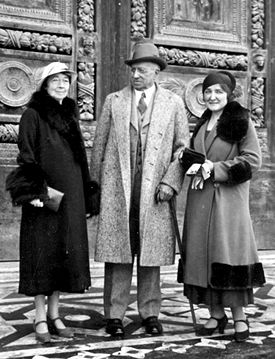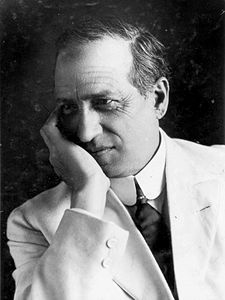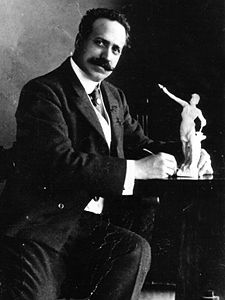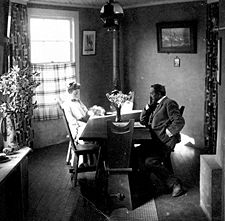Giuseppe Moretti: Difference between revisions
No edit summary |
No edit summary |
||
| Line 42: | Line 42: | ||
Moretti's most important works in Alabama, other than Vulcan, include the [[Mary Cahalan statue]] in [[Linn Park]], the [[Patrick O'Reilly statue]] at [[St Vincent's Hospital]], and the work most prized by Moretti himself, ''[[Head of Christ]]''. Moretti said of that carving, "I selected the marble myself with infinite care, the very first piece from the Sylacauga quarries ever to be used for an artistic purpose." He also told his friend, Alice Jeffress Boswell, "I have a peculiar affection for it. Where I go, my Christ goes also.... I feel that the final resting place of this first sculpture from Alabama marble should be in that state." | Moretti's most important works in Alabama, other than Vulcan, include the [[Mary Cahalan statue]] in [[Linn Park]], the [[Patrick O'Reilly statue]] at [[St Vincent's Hospital]], and the work most prized by Moretti himself, ''[[Head of Christ]]''. Moretti said of that carving, "I selected the marble myself with infinite care, the very first piece from the Sylacauga quarries ever to be used for an artistic purpose." He also told his friend, Alice Jeffress Boswell, "I have a peculiar affection for it. Where I go, my Christ goes also.... I feel that the final resting place of this first sculpture from Alabama marble should be in that state." | ||
Other locally-held works include the baptismal font at [[1st Presbyterian Church of Birmingham]] | Other locally-held works include the baptismal font at [[1st Presbyterian Church of Birmingham]], the [[William Elias B. Davis statue]] at [[Hillman Hospital]], and a [[1904 Moretti bas-relief|small marble bas-relief]] he gave to [[James MacKnight]] in [[1904]] (donated to [[Vulcan Park]] in [[2011]]) | ||
Moretti's notable work in Pittsburgh includes the Highland Avenue and Stanton Avenue entrances to Highland Park, executed in granite with bronze groups and figures; the four marble panthers erected on Panther Hollow Bridge; and the Stephen Collins Foster Memorial, which includes a rendering of "Old Black Joe" playing the banjo at the feet of the composer. | Moretti's notable work in Pittsburgh includes the Highland Avenue and Stanton Avenue entrances to Highland Park, executed in granite with bronze groups and figures; the four marble panthers erected on Panther Hollow Bridge; and the Stephen Collins Foster Memorial, which includes a rendering of "Old Black Joe" playing the banjo at the feet of the composer. | ||
== | <!--==Trivia== | ||
In 2008, the [[Sheraton Birmingham Hotel]] opened [[Moretti's]], a lobby cocktail lounge featuring enlarged historical photographs of Moretti and his work, as well as four original sculptures on loan from the [[Birmingham Museum of Art]].--> | |||
In 2008, the [[Sheraton Birmingham Hotel]] opened [[Moretti's]], a lobby cocktail lounge featuring enlarged historical photographs of Moretti and his work, as well as four original sculptures on loan from the [[Birmingham Museum of Art]]. | |||
==References== | ==References== | ||
" | * "[http://en.wikipedia.org/w/index.php?title=Giuseppe_Moretti Giuseppe Moretti]" (February 10, 2011) Wikipedia, The Free Encyclopedia - accessed February 9, 2011 | ||
* Ohio Historical Society. (October 30, 2006) "[http://www.ohiochannel.org/your_state/remarkable_ohio/marker_details.cfm?marker_id=6873 Giuseppe Moretti]". Text of historical marker at the Toronto, Ohio Soldiers and Sailors Monument. | * Ohio Historical Society. (October 30, 2006) "[http://www.ohiochannel.org/your_state/remarkable_ohio/marker_details.cfm?marker_id=6873 Giuseppe Moretti]". Text of historical marker at the Toronto, Ohio Soldiers and Sailors Monument. | ||
* Evert, Marilyn and Vernon Gay (1983) ''Discovering Pittsburgh's Sculpture''. Pittsburgh, Pennsylvania: University of Pittsburgh Press. ISBN 0822934671 | * Evert, Marilyn and Vernon Gay (1983) ''Discovering Pittsburgh's Sculpture''. Pittsburgh, Pennsylvania: University of Pittsburgh Press. ISBN 0822934671 | ||
* Whiting, Marvin Y., ed. (December 1985) "Giuseppe Moretti." ''Journal of the Birmingham Historical Society''. No. 9. pp. 5-13, 60 | |||
* Willard, Jennifer M. (Spring 1991) "[http://www.bplonline.org/Archives/moretti/gmoretti.htm Giuseppe Moretti]". ''Alabama Heritage''. No. 20 | * Willard, Jennifer M. (Spring 1991) "[http://www.bplonline.org/Archives/moretti/gmoretti.htm Giuseppe Moretti]". ''Alabama Heritage''. No. 20 | ||
* Fowler, Miriam Rogers, ed. (2002) "Giuseppe Moretti Master Sculptor and Father of Vulcan". exhibition catalogue. Birmingham Museum of Art | |||
* Fowler, Miriam Rogers (December 2002) "Giuseppe Moretti: Master Sculptor." ''American Art Review''. No. 16, pp. 142–49, 175 | |||
* Cason, Bob (Summer 2004) "[http://www.findarticles.com/p/articles/mi_qa4113/is_200407/ai_n9418230 Moretti's Warning: The Myth Demystified]." ''Alabama Heritage'' | * Cason, Bob (Summer 2004) "[http://www.findarticles.com/p/articles/mi_qa4113/is_200407/ai_n9418230 Moretti's Warning: The Myth Demystified]." ''Alabama Heritage'' | ||
* Morris, Philip A. (1995) ''Vulcan and His Times''. Birmingham: Birmingham Historical Society. | * Morris, Philip A. (1995) ''Vulcan and His Times''. Birmingham: Birmingham Historical Society. | ||
* Whiting, Marvin Yeomans (December 1985) "Landmark: Giuseppe Moretti." ''Journal of the Birmingham Historical Society.'' Vol. 9, No. 1 | * Whiting, Marvin Yeomans (December 1985) "Landmark: Giuseppe Moretti." ''Journal of the Birmingham Historical Society.'' Vol. 9, No. 1 | ||
* Fowler, Miriam Rogers (2002) ''Giuseppe Moretti: Master Sculptor and Father of Vulcan.'' Exhibition catalog. Birmingham Museum of Art. ISBN 0931394511 | * Fowler, Miriam Rogers (2002) ''Giuseppe Moretti: Master Sculptor and Father of Vulcan.'' Exhibition catalog. Birmingham Museum of Art. ISBN 0931394511 | ||
* Fowler, Miriam Rogers (October 5, 2009) "[http://www.encyclopediaofalabama.org/face/Article.jsp?id=h-1600 Giuseppe Moretti]" Encyclopedia of Alabama - accessed February 9, 2011 | |||
* Gray, Jeremy (February 9, 2011) "Sculpture by Vulcan artist added to museum atop Red Mountain." ''Birmingham News'' | |||
==External links== | ==External links== | ||
Revision as of 20:17, 9 February 2011
Giuseppe Moretti (born February 3, 1857 in Siena, Italy; died February 1935 in San Remo, Italy) was a sculptor who became well-known in America for his public monuments. Most notable among his works are Vulcan, the largest cast-iron statue ever made, which was cast for the 1904 World's Fair.
Early life
Giuseppe Moretti was born in Siena in 1857, the nephew of Vincenzo Cardinal Moretti, a noted patron of art. He began studying marble sculpting at the age of nine with the monks of San Domenico and with sculptor Tito Serrochi, whose studio was in the cloister of the church in Siena.
Moretti's precocious nature is emphasized in an anecdote about his early fascination with becoming an artist. Apparently aware that distant Florence was the nexus of Italian art, the young Moretti set off down the road in search of a career in the art world. An alert neighbor returned the would-be runaway, and soon after, Moretti was placed under the tutelage of Serrochi.
Moretti later studied at the Academy of Fine Arts in Florence, working in the studio of Giovanni Dupre.
Intrigued by the medium of marble, Moretti moved to Carrara to perfect his skill. In about 1879, a Dalmatian sculptor who saw his work was impressed and invited Moretti to assist him in his studio in Agram (now Zagreb), Croatia. Moretti set up shop there and made several important commissions before a large earthquake devastated the area in 1880.
Moretti decided to leave, He applied for permission to emigrate to the United States. In the meantime, he went to Vienna, Austria, where he worked on the Rothschild palace. He executed a marble bust of the Emperor Franz Josef that was later exhibited at the Paris Exposition of 1900, winning a bronze medal.
Moretti, now a widower, next took up residence in Budapest, Hungary, where he executed some works to commemorate the city's history. A dispute with German authorities over a marble field that Moretti wanted to use for his projects and as an incentive to local sculptors frustrated Moretti, and, in the summer of 1888 he emigrated to the United States.
America
Moretti arrived in New York City and opened a studio with fellow artist Carl Bitter. Soon, with the patronage of architect Richard Morris Hunt, Moretti was working on his first commission in America: Sculpture for the "Marble House" of William Kissam Vanderbilt in Newport, Rhode Island. On this project, Moretti produced the interior marble friezes and statuary, including bas-reliefs of Hunt and French architect Jules Hardouin Mansart, which stood side by side on a stair landing.
Edward Bigelowm director of public works for Pittsburgh, Pennsylvania, commissioned Moretti to produce a series of works for Schenley Park in 1885. Moretti immediately recognized the potential of Pittsburgh's rugged terrain for such a vast project. Arthur Arton Hamerschlag, the first president of the Carnegie Institute of Technology, also did much to popularize Moretti's work in Pittsburgh. When Bigelow failed to get reelected, Moretti's commission was discarded by the new city officers.
The first of many failed business ventures for Moretti was in 1897, when he and fellow Italian immigrant Riccardo Bertelli launched a small bronze foundry the December of that year with the help of a $20,000 loan from another Italian immigrant, Celestino Piva, who was a wealthy silk importer. However, in two years the company had collapsed and Pivo withdrew support. Yet Bertelli bought out Moretti's share, reorganized the business, and renamed it "Roman Bronze Works." By 1900 the foundry had relocated from Manhattan to Brooklyn, secured the financial backing of Piva once again, and acquired the exclusive casting rights to the works of American sculptor Frederic Remington.
Meanwhile, Moretti was pursuing a career in business by purchasing marble quarries. He was most interested in the white marble of Sylacauga, proclaiming it superior to the well-known product of Carrera. He became a pioneer in the Alabama marble industry beginning in 1901, but was largely unable to achieve the kind of development in the quarrying industry that would bring profit. Also an amateur operatic singer, Moretti joined the Liederkranz Club and befriended Enrico Caruso.
Alabama
Despite his business failings, Moretti retained his reputation as an artist, and soon won his most famous commission from James A. MacKnight, secretary of Birmingham Commercial Club. Moretti agreed to charge only $6,000 for the massive plaster model of Vulcan, which was to be Birmingham's contribution to the St Louis Exposition. Moretti created the model in New York City, then moved to Alabama to work on the sculpture in 1904. The enormous figure was displayed, along with other displays of mineral wealth from the Birmingham District in the Hall of Mines and Metallurgy at the fair, where it won a silver medal.
Having discovered Alabama's rich marble deposits, Moretti made it a personal goal to instate proper quarrying procedures for the material. He established a studio near the quarries in Sylacauga and took on an apprentice, the teenaged Geneva Mercer, a student at the Alabama Normal School in Livingston.
Moretti, with Mercer in tow, moved frequently after 1916, returning at one point to Pittsburgh, where he established a permanent residence and workshop on Bigelow Boulevard. The post-World War I demand for large memorials became a major source of income for Moretti's studio. He completed sculptures and tablets for Ohio, Pennsylvania, and elsewhere. Moretti is known to have remarked that "... art, in its various meanings is to be benefited greatly by the sentiment that the world war had reawakened..." Moretti also believed that Pittsburgh would become the "Athens of the New World," spurred on by artistic creation. "No," declared Moretti, "I shall not leave Pittsburgh - it is the fine home for the artist - strong, mighty, rugged-so!"
Return to Italy

In 1923, when he finally left Pittsburgh, Moretti bought his last Alabama marble quarry, which failed in 1925. With both his finances and his health failing, the sculptor decided to return to Italy with his wife, Dorothea Long Moretti, and his long-time assistant, Geneva Mercer, in 1930. He remained there until his death in San Remo in 1935.
Works
Moretti was a prolific artist, having completed twelve World War I memorials, nineteen monumental works, six church sculptures, twenty-four memorial tablets, fourteen cemetery memorials, twenty-seven sculptures in marble, bronze, and aluminum, and twenty-seven bronze statuettes. His aluminum bas-relief is believed to have been the first artistic work rendered in cast aluminum.
Moretti's most important works in Alabama, other than Vulcan, include the Mary Cahalan statue in Linn Park, the Patrick O'Reilly statue at St Vincent's Hospital, and the work most prized by Moretti himself, Head of Christ. Moretti said of that carving, "I selected the marble myself with infinite care, the very first piece from the Sylacauga quarries ever to be used for an artistic purpose." He also told his friend, Alice Jeffress Boswell, "I have a peculiar affection for it. Where I go, my Christ goes also.... I feel that the final resting place of this first sculpture from Alabama marble should be in that state."
Other locally-held works include the baptismal font at 1st Presbyterian Church of Birmingham, the William Elias B. Davis statue at Hillman Hospital, and a small marble bas-relief he gave to James MacKnight in 1904 (donated to Vulcan Park in 2011)
Moretti's notable work in Pittsburgh includes the Highland Avenue and Stanton Avenue entrances to Highland Park, executed in granite with bronze groups and figures; the four marble panthers erected on Panther Hollow Bridge; and the Stephen Collins Foster Memorial, which includes a rendering of "Old Black Joe" playing the banjo at the feet of the composer.
References
- "Giuseppe Moretti" (February 10, 2011) Wikipedia, The Free Encyclopedia - accessed February 9, 2011
- Ohio Historical Society. (October 30, 2006) "Giuseppe Moretti". Text of historical marker at the Toronto, Ohio Soldiers and Sailors Monument.
- Evert, Marilyn and Vernon Gay (1983) Discovering Pittsburgh's Sculpture. Pittsburgh, Pennsylvania: University of Pittsburgh Press. ISBN 0822934671
- Whiting, Marvin Y., ed. (December 1985) "Giuseppe Moretti." Journal of the Birmingham Historical Society. No. 9. pp. 5-13, 60
- Willard, Jennifer M. (Spring 1991) "Giuseppe Moretti". Alabama Heritage. No. 20
- Fowler, Miriam Rogers, ed. (2002) "Giuseppe Moretti Master Sculptor and Father of Vulcan". exhibition catalogue. Birmingham Museum of Art
- Fowler, Miriam Rogers (December 2002) "Giuseppe Moretti: Master Sculptor." American Art Review. No. 16, pp. 142–49, 175
- Cason, Bob (Summer 2004) "Moretti's Warning: The Myth Demystified." Alabama Heritage
- Morris, Philip A. (1995) Vulcan and His Times. Birmingham: Birmingham Historical Society.
- Whiting, Marvin Yeomans (December 1985) "Landmark: Giuseppe Moretti." Journal of the Birmingham Historical Society. Vol. 9, No. 1
- Fowler, Miriam Rogers (2002) Giuseppe Moretti: Master Sculptor and Father of Vulcan. Exhibition catalog. Birmingham Museum of Art. ISBN 0931394511
- Fowler, Miriam Rogers (October 5, 2009) "Giuseppe Moretti" Encyclopedia of Alabama - accessed February 9, 2011
- Gray, Jeremy (February 9, 2011) "Sculpture by Vulcan artist added to museum atop Red Mountain." Birmingham News


